THE NEED AND CREATION OF THE PAN-MACEDONIAN ASSOCIATION
By Nina Gatzoulis, Supreme Secretary of the Pan-Macedonian Association, USA
with historical assistance by Marcus A. Templar and George Gatzoulis
If we were to examine various associations and benevolent societies in a global level we would find out that most of the associations originate from a need and some times a problem that people are facing at some point. The need to create the Pan-Macedonian Association of USA arose among the Macedonians of the Diaspora when they sensed that they had to protect the boundaries of their birthplace from the expansionistic view and greedy stance of their northern neighbors. To fully understand however, how the whole thing progressed to the point that an organization had to be created in order to protect its land, its history and its culture, it is necessary to bring up some historical facts that go back four millennia.
A BRIEF HISTORICAL OVERVIEW OF MACEDONIA
Ancient Macedonia, the land of Philip and Alexander, stretched on the north along the lines drawn between Ohrid – Prilep (Pelagonia), followed the flow of Crna Reka to Demir Kapija to the Mt. Orvylos (Macedonian Paeonia), to Mt. Rhodopi following the flow of River Nestos to the Aegean Sea.
The original Macedonians, the Macedonian Greeks arrived in the area around 2000 BC and they were descendants of the Heracleides. As such the ancient Macedonians were part of a larger and the last group of Greeks, which reached the area of present day Kastoria (Orestis) along with the Dorians, Acarnanians and Aetolians around 2000 BC. Herodotus, the father of history, very carefully describes the 800- year wanderings of that large group, which eventually split into three smaller groups. Just after the Trojan War, the first group under the leadership of Dorus inhabited Peloponnesus and the second group, the Acarnanians and Aetolians, went south. The third group marched east and by pushing the Phrygians, established the Kingdom of Macedonia on a loop of the River Aliakmon. The first king of Macedonia was Karanos who reigned between 813 and 786 BC. The first capital of Macedonia was Aiges but later King Archellaus (413-399 BC) moved the capital to Pella, which had direct access to the sea by way of the river Lydias (though the bay has silted up for many centuries).
During the time of King Philip II, 359-336 BC, Macedonia became one of the great powers of Europe. King Philip II was successful in uniting the Greek city-states under a Pan-Hellenic Union, which was essentially the Greek nation, as we know it today. Philip II in 337 BC and his son Alexander in 335 BC were chosen as the Commanding Generals of all Greeks except the Spartans in the Council of Corinth. Alexander III, also known as Alexander the Great, 336-323 BC, while the Commander General of all Greeks conquered most of the known world of his time, spreading the Greek language and tradition in the lands he conquered. The Greek Macedonian Empire was preserved by the descendents of Alexander until 168 BC, when the Romans conquered all the territories. Even then, however, the Greek language and culture continued to be the predominant influence.
During the Roman Conquest, which continued into the Byzantine Era – a period of about one thousand years – that Roman territory with Constantinople as its capital and Thessaloniki as a cultural and commercial center of the Empire, remained fully Greek. Furthermore during Justinian’s time it adopted the Greek language as the formal and official language of the Byzantine State.
Macedonia was invaded several times from the north from the third to the fourteenth centuries AD As a result of these invasions, the Bulgarians established in the summer of 681 AD and by the treaty of 716 they were awarded the territory between Mt. Haemus and the River Danube. That area until that time was a province of the Byzantine Empire. A tremendous attempt to gain Hellenic territories took place at the end of the 10th century AD by the Bulgarian king Samuil, who after he occupied territories reaching South Greece, his army was chased and badly annihilated at Kleidion (Belasica), close to Strumica on July 29, 1014. For his cruelty the conqueror, Emperor Basil II of the Macedonian Dynasty, was given the infamous name, “the Bulgar-slayer.” The Serbs grew to become a power and attempted periodic invasions since their appearance in the southern Balkans, in the ninth century. It was during this time that the Ottoman Empire was organized and by the fifteenth century, Thessaloniki (1430) and Constantinople (1453) followed the rest of the Balkans and Asia Minor by falling in the hands of the Turks.
During the Turkish Occupation, Macedonia preserved its Greek identity, in perpetuity, through Greek language, religion and culture. Greek schools were allowed to open and function in Thessaloniki, Kozani, Siatista, Naoussa, Veroia and Serres, as was the case in the rest of Greece. When the Turkish rule made this impossible, schools functioned secretly in the churches. In 1904 a systematic guerrilla effort on the part of the Macedonians with considerable ammunition and troops from the free Greeks started the Macedonian Struggle, which ended in 1908 with the “Young Turk” movement in Turkey. Many glorious figures emerged from the Macedonian Struggle, among them Pavlos Melas (a.k.a. by the klepht name of Mikis Zesas), Germanos Karavangelis, Ion Dragoumis, Kotas, Lambros Koromilas, Constantine Mazarakis, Telos Agras, etc.
The eventual union with free Greece saved Macedonia from falling in the hands of the Slavs during the Balkan Wars (1912-13).
The struggle against the Ottoman occupant began in 1821 in southern Greece and that part of the Greek world was finally liberated in 1832. During the Balkan Wars of 1912-13, Greece liberated its province of Macedonia, as well as other Greek regions from the Ottoman rulers. Ambassador Morgenthau, in his book I Was Sent to Athens, mentions: “The Greek Independence, which came to a successful conclusion in 1832, affected less than one half of the Greeks in the Turkish Empire. It did not bring freedom to the Greeks of Macedonia and Thrace, of Crete and the Aegean islands…” Presently, Hellas retains friendly relations with all its neighboring countries.
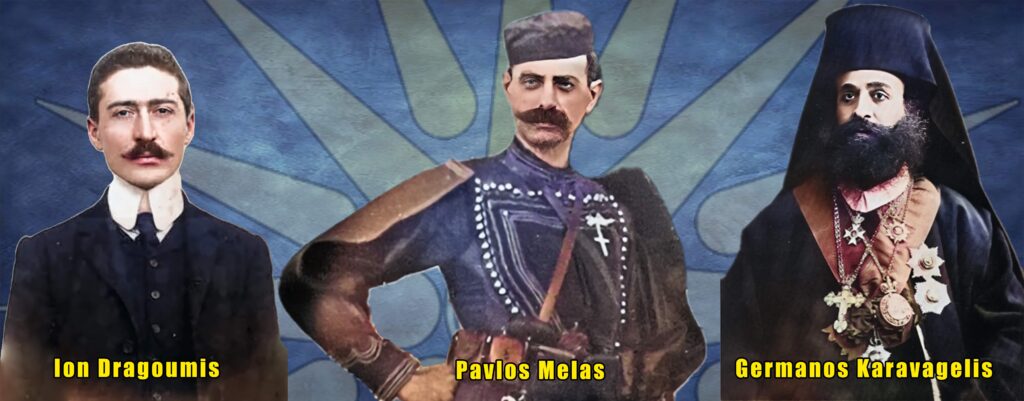
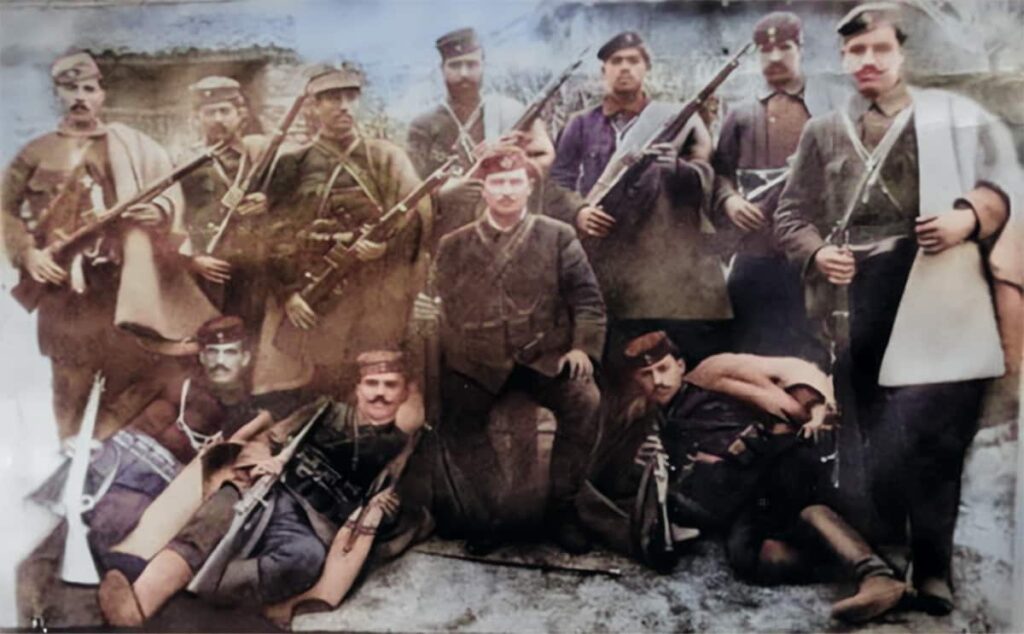
Periklis Drakos from Kavala with co-fighters
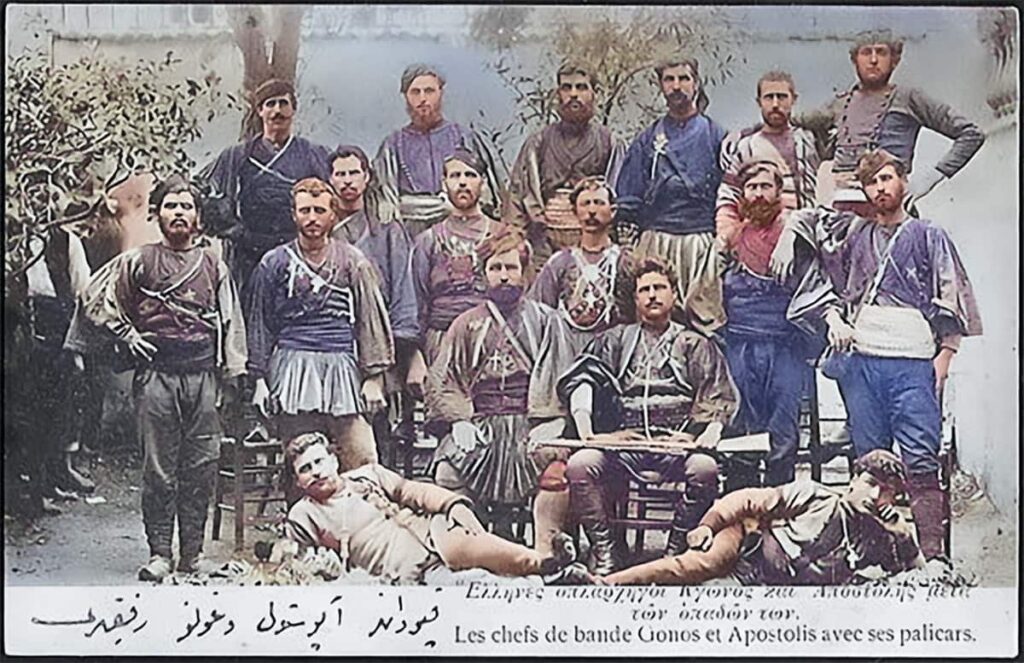
The band of Gonos Yiotas (seated right) and Apostolis Matopoulos (seated left).
TITO’S PROPAGANDA
Before 1944 the area that later comprised of the former Yugoslavia’s southern republic was not called Macedonia but was called Vardarska Banovina (Province -of the river- Vardar). It was in 1944 that (Joseph Broz) Marshal Tito, the Communist dictator ruling Yugoslavia at that time, created Yugoslavia’s southern republic and called it “People’s Republic of Macedonia”. However, “Macedonia” was already the name of one of Greece’s northern provinces.
It is pertinent to note that Tito’s “People’s Republic of Macedonia” consisted of only a small part of ancient Macedonia and a far larger part from Slavic Yugoslavia. There is no doubt that creating this Republic in the southern region in Yugoslavia and including “Macedonia” in its name was deliberate with the main intention of laying claim to the region of ancient Macedonia of the northern province of Greece. Particularly, what Tito and his Communist allies wanted was the city of Thessaloniki with its lucrative warm water port.
After 1944 a deliberate and systematic campaign was initiated for Yugoslavia’s southern republic to take over the history of ancient Macedonia. “Scholars” from the “People’s Republic of Macedonia” were commissioned to re-write their history books to include the ancient Macedonian History according to the wishes of the League of Communists of communist Yugoslavia, accompanied by perverted maps showing their “Macedonia” going all the way down to the northern half of Mount Olympus. Also, “linguists” led by Blagoj Konev, a.k.a. Blaže Koneski, were appointed to create the alphabet for and refine the “newly discovered” Macedonian language, which, of course, was made to sound as if it were the “natural development” of the ancient Macedonian language. Through their control of mass media and education, the government of “People’s Republic of Macedonia” then introduced this language and claimed that it is the language that was spoken by the ancient Macedonians.However, this language is grammatically nearly identical to Bulgarian and, due to continuous government interventions, its vocabulary tends to include more Serbo-Croatian words that have replaced the Bulgarian words. They clearly overlooked the unquestionable fact that the inhabitants of ancient Macedonia were Greeks and spoke the Greek language. Numerous excavations in all of the ancient Macedonia area have consistently unearthed relics clearly with Greek writings, and depictions of rulers clearly designated with Greek names.
According to classified documents of the British Foreign Office recently released, the Prime Minister of Greece knowing that the communist government of Yugoslavia was working on changing the Constitution of the country, requested in 1962 from Josip Broz Tito to change the name of the “People’s Republic of Macedonia”. President Tito at first agreed, but pressured by the ultra-nationalists turned hard-core communists of Skopje, did not fulfill the promise. The Constitution of the Federal People’s Republic of Yugoslavia changed, among other things, the name of the country, but also the name of the “People’s Republic of Macedonia to “Socialist Republic of Macedonia”.
NEED FOR AN ASSOCIATION
The Macedonian immigrants made numerous fruitless efforts to establish a “Macedonian Organization” to unite them in their newly adopted country, America as soon as they were set up in the new land. However being alerted of the vicious and systematic propaganda emanating from their neighbors in their Macedonia’s northern boundaries, they decided to rebut the misinformation that was spreading all too fast. They were especially alarmed during the Roosevelt administration in 1944 by the “Circular Airgram” of Secretary of State, Stettinius, informing the US government officials about a “Macedonian National Consciousness”, “Macedonian Fatherland”, or “Macedonian Nation.” The USA Macedonian population suspected the aggressive intentions against Greece and decided to do something about it. This is an excerpt from the circular by Secretary of State Stettinius.
Foreign Relations Vol. VIII
Washington D.C.
Circular Airgram
(868.014/26 Dec. 1944)
The Secretary of State to Certain Diplomatic and Consular Officers*
The following is for your information and general guidance, but not for any positive action at this time.
The Department has noted with considerable apprehension increasing propaganda rumors and semi-official statements in favor of an autonomous Macedonia, emanating principally from Bulgaria, but also from Yugoslav Partisan and other sources, with the implication that Greek territory would be included in the projected state. “This Government considers talk of Macedonian “nation”, Macedonian “Fatherland”, or Macedonia “national consciousness” to be unjustified demagoguery representing no ethnic nor political reality, and sees in its present revival a possible cloak for aggressive intentions against Greece”.
The approved policy of this Government is to oppose any revival of the Macedonian issue as related to Greece.
The Greek section of Macedonia is largely inhabited by Greeks, and the Greek people are almost unanimously opposed to the creation of a Macedonian state. Allegations of serious Greek participation in any such agitation can be assumed to be false. This Government would regard as responsible any Government or group of Governments tolerating or encouraging menacing or aggressive acts of “Macedonian Forces” against Greece. The Department would appreciate any information pertinent to this subject, which may come to your attention.
STETTINIUS
Especially instrumental was the presence of the Macedonian cleric in the Washington area since the 1920s. Father Thomas Daniels from Morfi, West Macedonia, of the Greek Orthodox Church of St. Constantine and Helen in Washington DC, was a close friend to President Harry Truman. The President of the United States valued the Greek clergyman’s friendship so highly that he offered Father Daniels space in the White House to use for his office. The President confided to Father Thomas that in the White House there are certain rumors “about the formation of a “Macedonian State” in the Balkans”. Immediately Father Daniels informed Archbishop Athenagoras about the plans of the Slavs and instant action was taken. The Macedonians without any faltering and on April 28, 1946 during a meeting in Detroit founded the Pan-Macedonian Association. Immediately the group moved to secure its charter from the State of Illinois. The Chicago-Detroit groups communicated with New York on the subject and left the initiative for the New York Macedonians to assemble all the Macedonian groups from USA. Following a series of conferences and communicating with all groups concerned, a general conference was called in New York on January 21, 1947, where the first general Pan-Macedonian Provisional Committee was formed. It consisted of the Chairman, Mr. Stephen Ladas, the Treasurer Mr. Nicholas Bourkas and the Secretary, Mr. Nicholas J. Matkos. Themistocles Economides and James Voziou were members. This committee called the first Convention of the Association at the Plaza Hotel in New York, on September 21, 1947.
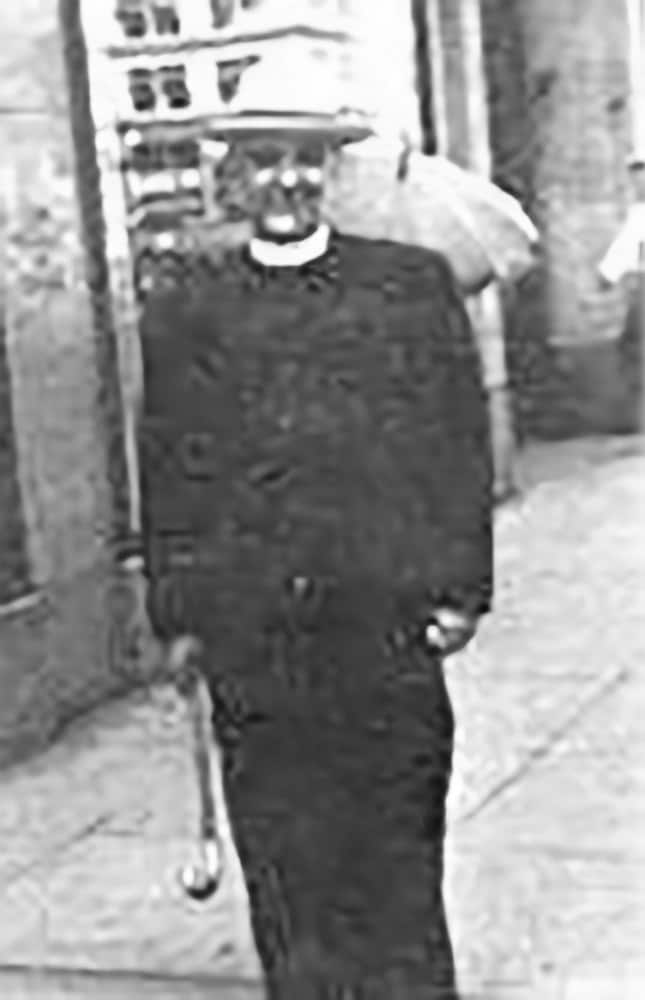
Father Thomas Daniels
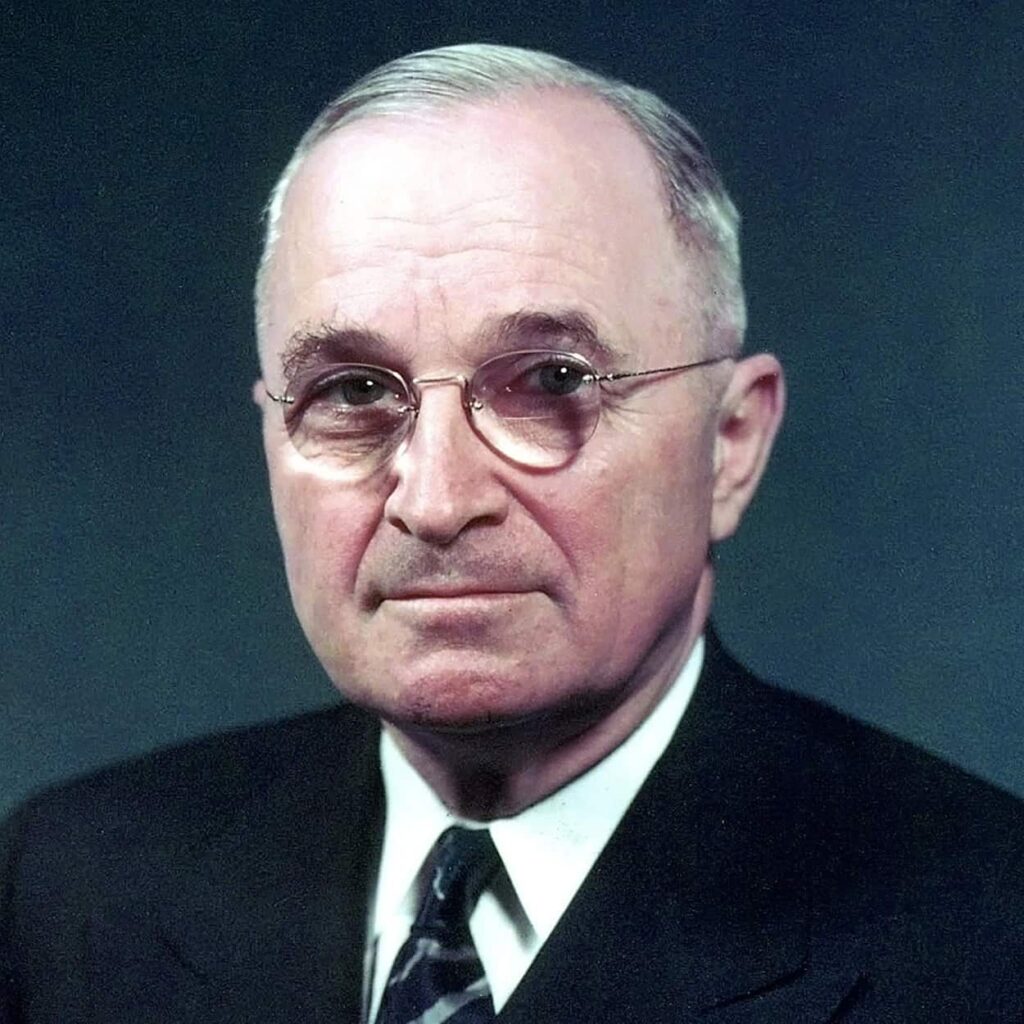
President Harry Truman
It was during this Convention that the by-laws were established and the foundation was laid as to the purpose and aims of the organization. The main purpose of the Organization’s function, as it is stated in the Association’s booklet which, includes the goals and aims of the Pan-Macedonian Association, is: “In addition to its strength which enables it, as a large organization, to have a bond, a communication network for the Macedonians of the Diaspora, it accomplishes an important task in projecting our history, in perpetuating our cultural heritage and in informing our fellow American and Canadian citizens that they may not fall as victims of misinformation”.
It was in 1947 that the Truman Doctrine/Marshal Plan was adopted, according to which support would be offered to Greece by the USA to defeat the Communist movement that was spreading in the Greek peninsula. The Truman Administration, by means of the above mentioned Doctrine and the help of the American monetary aid, along with the sacrifices of the Greek people, the blood of hundreds of thousands of Greek dead and wounded, saved Greek Macedonia from the Communist threat.
THE FORMER YUGOSLAV REPUBLIC OF MACEDONIA (THE FYROM)
In September of 1991 the southern part of the broken up Yugoslavia named itself “Republic of Macedonia” and declared itself a new independent country. The inhabitants designed a new flag with the Sun of Vergina at its center and printed new currency with the White Tower of Thessaloniki, symbols clearly from the northern province of Greece. Because of these actions and also because of certain articles in their newly adopted constitution which implied that the their country had territorial rights to all of the ancient Macedonian area, Greece imposed a trade embargo and prevented any trade commerce through Greece’s northern border. Greece reluctantly lifted the trade embargo when The FYROM redesigned and accepted a new flag, stopped the issuance of the new currency with the depiction of the White Tower of Thessaloniki, and passed amended articles to their constitution implying that they have no territorial rights outside their present boundaries.

Currency with the White Tower of Thessaloniki which was intended for circulation but was withheld because of objections from Greece. The word in small print under the depiction of the city is “СОЛУН”–“THESSALONIKI”
Greece, however, continued to object to their use of the name Macedonia. Because of this objection, the United Nations accepted this nation as a new member with the temporary name of “The Former Yugoslav Republic of Macedonia.” (UN Resolutions #817 of April 7 and #845 of June 18 of 1993) until a permanent solution to the name is found. To this date no solution has been found and the UN deadline of September 13, 2002 has passed by with the two countries only agreeing to extend discussions on this matter for one more year. Presently, internal strife between the various minorities within The FYROM has placed the country on the verge of collapse. Albania (since about 1/4 of The FYROM territory is ethnically Albanian)and Bulgaria are anxiously waiting on the sidelines for this to happen to quickly rush in and grab a piece of it. On the other hand, Greece maintains a position of a staunch supporter for the survival of this country.
TODAY’S ROLE OF THE PAN-MACEDONIAN ASSOCIATION
The function of the Pan-Macedonian Association presently remains steadfast to the fact that the name “Macedonia” was is and will be Greek and it only belongs to Greece. This matter for the members of the Association does not incorporate any political convictions, but they strongly believe that the issue is cultural, linguistic, historical and ethnic. It is a matter of their identity that cannot be negotiated, and an issue of their heritage that cannot be disputed or spared. The FYROM desires to be called “Macedonia” and by usurping the name, it appropriates the Greek history and many other elements that go with the name, such as identity, ancestry, culture, ethnicity, belonging, cohesiveness, texture, color, and many other qualities. The FYROM’s Orthodox Church wants frantically to be called “Macedonian Orthodox Church” for some time now, thus attempting to persuade the world that the name “Macedonia” is rightfully theirs from another scope, the religious range.
The FYROM Orthodox Church did not hesitate to present the Greek Orthodox history as its own, speaking and including all of the geographic Macedonia, even appropriating the two Greek-Byzantine Saint brothers, Cyril and Methodius, claiming them as Byzantine-“Macedonians” (meaning Byzantine-Slavs). This is all included in the webpage http://www.mpc.org.mk/html_a/ahistor.html that is posted under the auspices of the FYROM’s Ministry of Culture. The members of the Pan-Macedonian Association however, shall never accept an Orthodox Church with the term “Macedonia” or its derivatives in its name. These therefore are the issues, which are not negotiable for the Pan-Macedonian Association of USA!
Nevertheless, the members of the Association, support and assist every issue that their place of origin, Greece faces. As it was voted in the 57th National Convention in Florida on June 2002, the Association supports all rights of the Northern Epirus Brethren. The members feel that the terrorism and the illegal pressures laid upon them are against international law and violate their human rights. The Pan-Macedonian Association castigates the uneven, willful, and unfair treatment of occupied Cyprus from the USA, European Union and NATO as compared to Kosovo.
The continuing Turkish provocations and demands for territorial concessions in the Aegean Sea, in plain violation of all International Laws and Conventions are condemned since they are against the current legal views on international relations. The members regard the continued discriminatory acts, rules and policy of Turkey towards the Orthodox Ecumenical Patriarchate in Constantinople a violation of freedom of religion and hypocritical in its claims to be a free country. In particular, the reopening of the Theological School of Halki, and the restoration of the property rights of the Greeks in Constantinople should be accomplished. Furthermore the Association supports the just return of the Parthenon Marbles to the place of their origin and it also supports the efforts for the success of the 2004 Olympic Games in Athens. On an international level the members condemn the terrorist attacks of 9-11-01 in the USA and terrorist acts anywhere in the world.
ACCOMPLISHMENTS OF THE PAN-MACEDONIAN ASSOCIATION
The formation of the Pan-Macedonian Association might have started from the need to protect the Macedonian land that was indisputably and unquestionably Greek; however the members of the Association expanded their efforts in various educational, philanthropic and charitable activities. On different occasions the Pan-Macedonian Association has organized lectures, scientific discussions, has supported art exhibitions and various symposia, such as the one at Columbia University of New York, which took place from June 26th to June 30th of the year 1989.
The Association through an endowment founded a wink in the Library of New York University, which displays only books about the Macedonian history culture and art. In the “Macedonian Home” in New York tutorial sessions for school children take place almost on a daily basis. Also older students, the candidates for collegial level, benefit at the “Macedonian Home”, where they get help for their SATs. After September’s 11th 2001, terrorist act, the chapters of the Association contributed $21,000.00 toward the World Relief Fund for the victims of the horrible, terrorist activity. The Association also grants scholarships to needy students of Macedonian descent.
Metropolitan Iakovos of Sissanio/Siatista Bishopric during his visit to USA in 1951 asked the Pan-Macedonian Association to contribute one third of the cost for the Tsotyli High School Dormitory for students. “Aliakmon” Benevolent Association conducted the fund-raising and a handsome building was constructed in Tsotyli, Kozani. The Pan-Macedonian Association through the Earthquake Relief Fund contributed hundreds of thousands of dollars to the different regions of Greece, subjected to the devastated effect of the earthquakes, since Greece is a seismic region. The chapters of the Pan-Macedonian Youth spread the Greek Macedonian culture through their dancing performances, thus perpetuating the Macedonian traditions to the future generations.
During the 50s the Pan-Macedonian Association undertook the task of building various health centers in Western Macedonia. Thus the hospital in Grevena was erected in the year 1953 and on the same year the Health Center in Tsotyli was also built. Also the Association purchased an ambulance for the sole purpose of quickly transporting patients from remote villages of Western Macedonia to more urban areas, where adequate medical help could be provided.
The International Building of Alexander the Great at Dion, Pierias however, is the Association’s magnum opus. The idea originated and matured during the various national conventions of the Association, until it was materialized with the aid of various establishments and agencies in Greece as well as in USA. Its main purpose is to house the history of Alexander the Great. Eventually it will house a complete library, an ambitious museum and a historical exhibition of monuments and artifacts of Alexander the Great. It is a magnificent building and the pride of the Association.
ADMINISTRATION OF THE ASSOCIATION
The Supreme Council is the highest administrative body of the Association and is elected annually during the Convention.
Delegates represent the chapters and the number of delegates depends on the number of members who are in good standing. The ratio is 15 members to one delegate, not counting the president of the organization at all times. If additional delegates are interested in attending the convention, they may participate as alternates, thus participating in all of the meetings and functions, without having the right to vote, or to be elected.
The Supreme Council is composed of the following:
1. Supreme President
2. Supreme Vice President
3. Supreme Secretary
4. Supreme Treasurer
5. Vice President of Youth Chapters
6. District Governors
7. Past Presidents of the Association
COMMITTEES
Several committees exist and operate to cover the extensive range of the Association’s tasks. The most significant are:
1. Committee for Macedonian Studies Center
This committee has the responsibility of organizing academic gatherings, symposia, lectures, seminars, etc.
2. Committee for the History of the Pan-Macedonian Association, Inc.
Its responsibility is to record the history of the Pan-Macedonian Association from its origination to the present.
3. Studies and Publications Committee
This is the committee that responds to anti-Greek publications, which are continuously published. Furthermore this committee informs and advises the Americans about our history.
4. Magazine Editorial Committee
Its duty is to publish the magazine “Makedonia” and mail it to the membership
5. Library Committee
Its duty is the establishment of libraries, forwarding books to libraries and individuals, cataloguing and preserving books in our possession.
6. Scholarship Committee
The purpose of this committee is to offer two scholarships to high school graduates in an annual basis and an additional scholarship to be given every three years to a student of post-graduate studies with a specialty in the history of Macedonia.
7. Constitutional Committee
Its responsibility is to uphold the Constitution of the Association.
8. Commemorative Coins Committee
Issuing of commemorative coins and other awards, which the Association confers on various honorees from time to time.
9. Building Committee
Its duty is to purchase a building if funds are available.
10. Fundraising Committee
The responsibility of this committee is to collect funds to support the treasury of the Pan-Macedonian Association, Inc.
11. Alexander the Great Monument and Cultural Center Committee
Its responsibility is to build a monument to Alexander the Great and to construct a Cultural Center which Will include an amphitheater, lecture hall, museum, etc.
12. Planning and Programming Committee
Its duty is to plan and program events for the future
13. Public Relations Committee
The Supreme President and all the members of the Supreme Council, especially the Governors, handle public relations.
14. Communications Liaison Committee
Its duties entail the maintenance of good relations with organizations and institutions in and out of the United States and Canada in order to coordinate our efforts in projecting our history and cultural heritage.
15. National Issues Committee
The promotion of our positions on the Macedonian issue, in cooperation with the lobbies of House and Senate committees and officials of the American government is the primary responsibility of this committee. Also, it has the responsibility of placing advertisements in the American press, which will seek to inform and shape public opinion.
16. Internet Committee
To establish, organize, maintain and oversee the World Wide Web Home Page of the Pan-Macedonian Association and its affiliate Organizations.
It is true that danger brings Greeks close together and they do unite to resist the risks that their beloved Greece might be facing from time to time. The Greeks of the Diaspora proved once more that wherever they go, wherever they live they carry the love for the place of their origins in their hearts. The Greeks of the USA formed an organization during the 40s to combat the propaganda towards their beloved Macedonia and the same Organization is still in full force today struggling with the same propaganda and at the same time uniting all the Greeks!
*Sources of the development of the Pan-Macedonian Association in USA were taken from Lazarus Papapaionnou’s book,
The Pan-Macedonian Association of America, Fifty Years of Activity.
